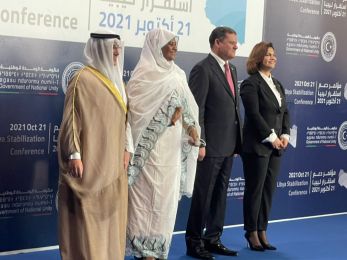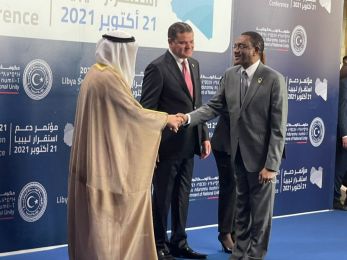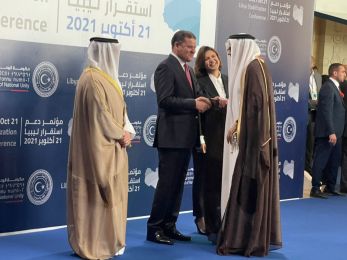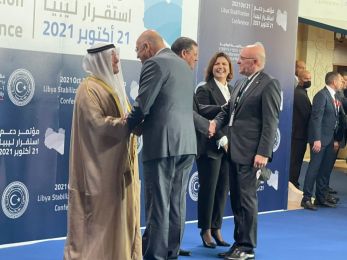PANAPRESS
Panafrican News Agency
India: 'The time for Africa is now – we can’t slow down, we must quicken the pace' - Adesina
Ahmedabad, India (PANA) - "India is the perfect place for the African Development Bank (AfDB) to focus on the transformative power of agriculture," Bank President Akinwumi Adesina declared to African, Indian and international press, on the sidelines of the 22-26 May, 52nd Annual Meetings of the bank in Ahmedabad, India.
“India is an inspiration to Africa, in that its Green Revolution took just three years. That was in large measure due to the power of political will,” he said on Monday, adding “and you will see much political will on display at Meetings in the next few days”.
Adesina continued: “See agriculture as agribusiness: it’s the best way to create jobs and make money. Our problem is that we have viewed African agriculture through the wrong lens for too many years. Agriculture is not a development activity or a social sector: it’s the biggest money-making business in the world. It’s not for older people – the average age of our African farmers is 60 – but it’s for young people. That’s why we have launched the ENABLE Youth programme with the aim of establishing 10,000 youth-run agribusinesses in every country in Africa.”
Adesina, a former Nigerian Agriculture Minister, stressed that agriculture is the most strategic sector for a country’s economic growth, and that a Minister of Agriculture needs to work hand-in-hand with a Minister of Finance and a Minister of Trade and Investment.
“And yet it’s only Government’s role to create policy, incentives and infrastructure – it’s ultimately the private sector, which must step up and invest along the length of the agricultural value chain, from producing to processing, from farm to fork.”
He asked, "What use is it that Africa produces 75% of the world’s cocoa beans, but produces only 2% of its chocolate." He answered, "We simply have to transform African agriculture. The African future is not, as some people think, based on oil and gas: you can’t drink oil or smoke gas. The future is food – you can eat food. Our continent’s food and agriculture markets will be worth US$1 trillion within 13 years.”
Thanking his Indian hosts, he said, “In the spirit of self-determination, the African Development Bank – and the continent for which it works – is proud to hold these Annual Meetings in the birthplace of Mahatma Gandhi.”
Setting the scene, he described the African continent holding its own economically against global headwinds and commodity price drops, and in large measure exceeding global patterns, with four of the world’s five fastest-growing economies being in Africa, 14 of its countries growing above 5% in 2016, and 18 between 3% and 5%.
He described a Bank “fit-for-purpose” and “stronger than ever before”, which made a record US$10.4 billion of approvals in 2016, and US$6.1 billion of disbursements. “These figures are the highest in our history,” he said.
Fielding questions about the Bank’s financial status and its capacity to fill the funding gaps that inhibit the continent’s growth, he stressed the Bank’s AAA credit rating, and its ability to unlock others’ funding – at a rate of some US$4 for every US$1 of its own – to finance development.
He pinpointed to the continent’s untapped wealth – US$334 billion a year in pension resources, which will rise to US$1 trillion by 2030, and US$164 billion in sovereign wealth funds. “There is no sense in these sovereign wealth funds investing outside Africa,” he said, “when they could be investing inside it”.
He charted the continent’s progress in raising tax resources and stemming illicit flows. “The Bank helped to establish a tax agency in Togo, and within 12 months, tax revenue had increased by 25%,” he said.
He cited the Bank’s partial risk and credit guaranty products designed to de-risk others’ lending, its capacity to coordinate syndicated loans (with a US$1 billion syndicated loan in 2016, across eight Banks, for the South African energy utility Eskom), and its co-financing arrangements, notably with China, Japan and Korea.
“So we are truly sweating the balance sheet,” he said.
“Our non-regional member countries support us with development funds,” Adesina confirmed, “but more importantly they invest in Africa for their own good. So India contributed US$27 million to our African Development Fund replenishment last year, … but in 2015 it announced a US$10 billion Line of Credit through the Exim Bank of India over the next five years for Indian companies wishing to invest in Africa.
"We have 80 member countries – yes, we need their resources, but we also need to help them increase their business and investment opportunities in Africa.”
Adesina also touched on the Bank’s first priority, to light up and power Africa. “We are the only multilateral finance institution in the world to have established a Vice-Presidency solely for energy,” he said.
Last year, the Bank approved US$1.96 billion in new energy funding. The Bank has highlighted the Ouarzazate Solar Complex Project in Morocco, with a US$100 million loan from the AfDB, which will create more than 1,800 jobs and produce energy for 1 million Moroccans.
“So I talk about money, of course, but above all I want to talk about the impact of the work of this Bank,” he said.
“What matters most to me is not the financial figures, but figures like the fact that in 2016 we estimate that 3.7 million Africans benefitted directly from the Bank’s work to improve water and sanitation. 3.3 million Africans benefitted from our work to improve electricity supply; 5.7 million from our work to improve agricultural yields; 9.3 million from our work to provide better healthcare; and 7.0 million from our projects to develop better transport systems. That is what this Bank is about – transforming African lives, and transforming the African continent.”
-0- PANA VAO/MA 23May2017
“India is an inspiration to Africa, in that its Green Revolution took just three years. That was in large measure due to the power of political will,” he said on Monday, adding “and you will see much political will on display at Meetings in the next few days”.
Adesina continued: “See agriculture as agribusiness: it’s the best way to create jobs and make money. Our problem is that we have viewed African agriculture through the wrong lens for too many years. Agriculture is not a development activity or a social sector: it’s the biggest money-making business in the world. It’s not for older people – the average age of our African farmers is 60 – but it’s for young people. That’s why we have launched the ENABLE Youth programme with the aim of establishing 10,000 youth-run agribusinesses in every country in Africa.”
Adesina, a former Nigerian Agriculture Minister, stressed that agriculture is the most strategic sector for a country’s economic growth, and that a Minister of Agriculture needs to work hand-in-hand with a Minister of Finance and a Minister of Trade and Investment.
“And yet it’s only Government’s role to create policy, incentives and infrastructure – it’s ultimately the private sector, which must step up and invest along the length of the agricultural value chain, from producing to processing, from farm to fork.”
He asked, "What use is it that Africa produces 75% of the world’s cocoa beans, but produces only 2% of its chocolate." He answered, "We simply have to transform African agriculture. The African future is not, as some people think, based on oil and gas: you can’t drink oil or smoke gas. The future is food – you can eat food. Our continent’s food and agriculture markets will be worth US$1 trillion within 13 years.”
Thanking his Indian hosts, he said, “In the spirit of self-determination, the African Development Bank – and the continent for which it works – is proud to hold these Annual Meetings in the birthplace of Mahatma Gandhi.”
Setting the scene, he described the African continent holding its own economically against global headwinds and commodity price drops, and in large measure exceeding global patterns, with four of the world’s five fastest-growing economies being in Africa, 14 of its countries growing above 5% in 2016, and 18 between 3% and 5%.
He described a Bank “fit-for-purpose” and “stronger than ever before”, which made a record US$10.4 billion of approvals in 2016, and US$6.1 billion of disbursements. “These figures are the highest in our history,” he said.
Fielding questions about the Bank’s financial status and its capacity to fill the funding gaps that inhibit the continent’s growth, he stressed the Bank’s AAA credit rating, and its ability to unlock others’ funding – at a rate of some US$4 for every US$1 of its own – to finance development.
He pinpointed to the continent’s untapped wealth – US$334 billion a year in pension resources, which will rise to US$1 trillion by 2030, and US$164 billion in sovereign wealth funds. “There is no sense in these sovereign wealth funds investing outside Africa,” he said, “when they could be investing inside it”.
He charted the continent’s progress in raising tax resources and stemming illicit flows. “The Bank helped to establish a tax agency in Togo, and within 12 months, tax revenue had increased by 25%,” he said.
He cited the Bank’s partial risk and credit guaranty products designed to de-risk others’ lending, its capacity to coordinate syndicated loans (with a US$1 billion syndicated loan in 2016, across eight Banks, for the South African energy utility Eskom), and its co-financing arrangements, notably with China, Japan and Korea.
“So we are truly sweating the balance sheet,” he said.
“Our non-regional member countries support us with development funds,” Adesina confirmed, “but more importantly they invest in Africa for their own good. So India contributed US$27 million to our African Development Fund replenishment last year, … but in 2015 it announced a US$10 billion Line of Credit through the Exim Bank of India over the next five years for Indian companies wishing to invest in Africa.
"We have 80 member countries – yes, we need their resources, but we also need to help them increase their business and investment opportunities in Africa.”
Adesina also touched on the Bank’s first priority, to light up and power Africa. “We are the only multilateral finance institution in the world to have established a Vice-Presidency solely for energy,” he said.
Last year, the Bank approved US$1.96 billion in new energy funding. The Bank has highlighted the Ouarzazate Solar Complex Project in Morocco, with a US$100 million loan from the AfDB, which will create more than 1,800 jobs and produce energy for 1 million Moroccans.
“So I talk about money, of course, but above all I want to talk about the impact of the work of this Bank,” he said.
“What matters most to me is not the financial figures, but figures like the fact that in 2016 we estimate that 3.7 million Africans benefitted directly from the Bank’s work to improve water and sanitation. 3.3 million Africans benefitted from our work to improve electricity supply; 5.7 million from our work to improve agricultural yields; 9.3 million from our work to provide better healthcare; and 7.0 million from our projects to develop better transport systems. That is what this Bank is about – transforming African lives, and transforming the African continent.”
-0- PANA VAO/MA 23May2017






